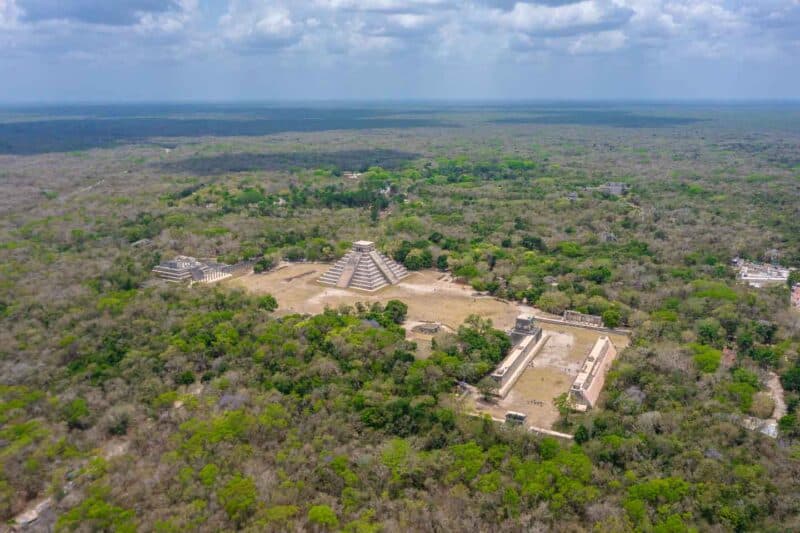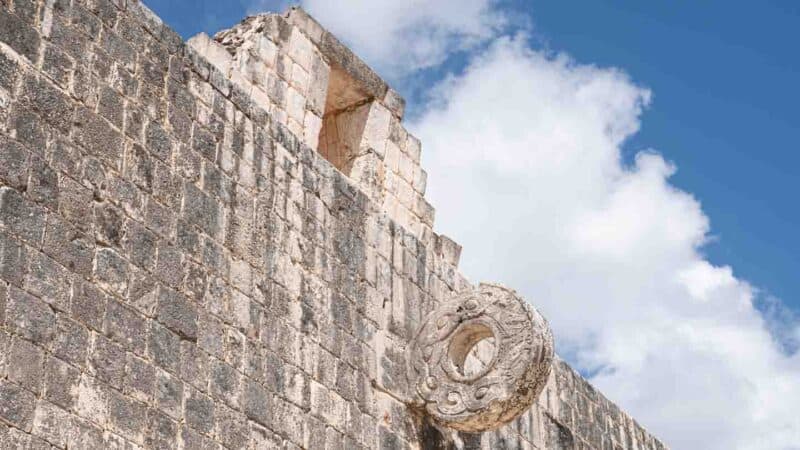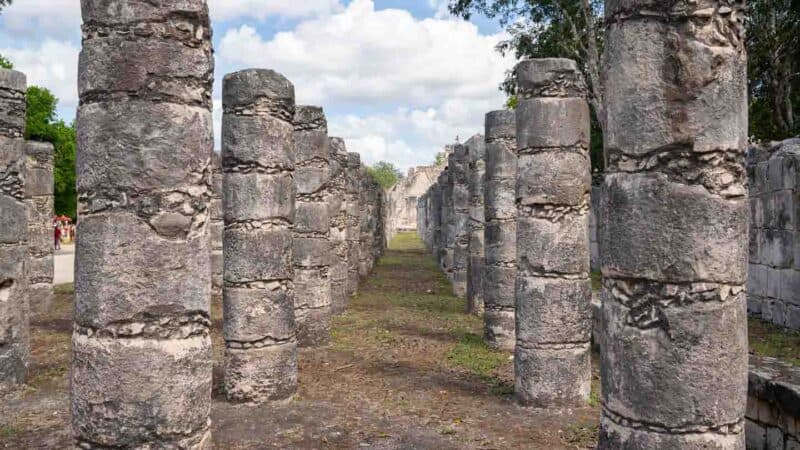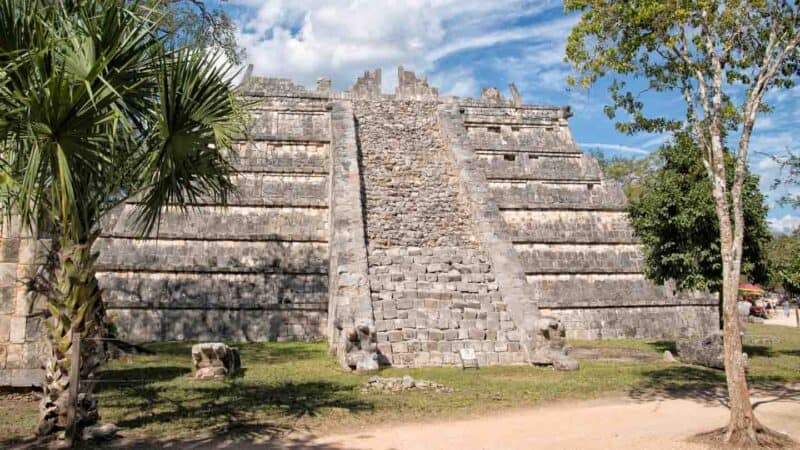Step 1,500 years back in history with a visit to Chichen Itza. As one of Mexico’s most visited archeological sites, a walk through the ancient ruins of Chichen Itza will give you a rare glimpse into Mayan life in Mexico.
As one of the biggest thriving Mayan communities of the ancient world, Chichen Itza is teeming with history. From pyramids and temples to ball courts and cenotes, there’s an entire world of culture just waiting to be explored.
In this article, we’ll cover everything you’ve ever wanted to know about this pre-Colombian city. If you’re wondering what there is to see at Chichen Itza ruins, or what insider tips you should know before arriving, then you’ve come to the right place.
Chichen Itza History
Located in the Yucatan Peninsula of Mexico, Chichen Itza attracts millions of visitors each year. The site is just 120 miles outside of Cancun, which makes it accessible from many cities around Mexico.
Due to its ancient history and cultural impact on Mexico, Chichen Itza is recognized as a UNESCO World Heritage Site. It’s was also voted as one of the Seven New Wonders of the World. Although it’s now considered one of Mexico’s most prominent attractions, its rich culture, and history date all the way back to 600 AD.
Early History
Chichen Itza was built on top of several underground rivers, which explains its name; Chichen Itza roughly translates to “at the mouth of the well of the Itza” in the Mayan language. Due to its central location, Chichen Itza became one of the most significant cities in Mayan culture.
By the 9th-century, Chichen Itza was considered the capital of the Yucatan Peninsula. Specializing in commercial trading, it became a hub for trading gold and other precious goods. Soon, the population grew to over 50,000 residents, many of who immigrated from Latin American and other parts of Mexico.
Mayan & Chichen Itza Peak
At the height of its rule, it was believed that Chichen Itza controlled the economic and political climate throughout the Yucatan. The city was two miles wide and filled with commercial and residential buildings, as well as temples and pyramids. Many historians believe that people also lived outside the city center, in smaller suburban neighborhoods.
During its golden age, the buildings in Chichen Itza were painted in a variety of bright colors, including reds, greens, and blues. Over time, these colors began to fade to grey.
Besides the pyramids, one of the most significant features of Chichen Itza are sacbeob. These paved roadways linked different buildings of the cities. Since most European cities didn’t even have sidewalks at the time, the sacbeobs are considered one of the most advanced features of the ancient city.
It is also believed that the economic growth of Chichen Itza contributed to the downfall of Yaxuna and Coba, two other thriving communities. However, it wasn’t long before the booming community started to fall itself.
Late History
By the mid-1200s, many residents left Chichen Itza for newer and even more powerful cities. Although some people stayed, they were eventually conquered by Spanish conquistadors in the 16th century.
Within 200 years, the conquistadors eventually left, deserting the city where it stands today. In the late 1800s, the United States ambassador Edward H. Thompson purchased the plot to the Yucatan. He spent the next 30 years excavating the site, which sparked interest from other archaeologists and research centers.
Today, Chichen Itza is one of Mexico’s top attractions and one of the best Mayan ruins in Mexico. Much of the city has been preserved or reconstructed to its original state, which makes it a unique place to visit during your trip to Mexico.
Chichen Itza Hours
Chichen Itza is open every day from 8 am until 5 pm. Chichen Itza ticket cost is 480 pesos per person. You must bring pesos, as the ticket office does not accept any other types of currency.
Once you arrive at Chichen Itza, you should give yourself plenty of time to explore. The sprawling complex is almost 750 acres, meaning there are many buildings and attractions to see. We recommend at least three or four hours to see everything in the ancient city.
Related Article: Best Things to Do In Riviera Maya & Places to Visit
How to Get to Chichen Itza
You’ll have several international airports to choose from when flying into Mexico. Merida is the closest airport to Chichen Itza. However, many visitors choose to fly into Cancun and then drive or commute to the ruins on a day trip from Cancun, Tulum, or Playa del Carmen.
If you are already in Mexico, then you have several ways of getting to Chichen Itza. The easiest way to reach Chichen Itza is by car. We usually rent a car in Mexico and can explore the area at our own pace. Make sure to read our guide on renting a car in Cancun. This way, you can arrive and leave on your own schedule.
- Cancun to Chichen Itza 3 hours
- Playa del Carmen to Chichen Itza 2 hours
- Tulum to Chichen Itza
- Valladolid to Chichen Itza 45 minutes
Public transportation is another option. If you are going from Cancun to Chichen Itza, you can take the ADO bus. It leaves Cancun daily at 8:45 am and returns from Chichen Itza at 4:30 pm. The trip takes roughly three hours.
Taxis from Valladolid to Chichen Itza are an option, but if you are in Cancun, Tulum, or Playa del Carmen, this will not be a good option. The price will be insane, and we have had very few good experiences with taxi drivers in the area offering reasonable rates. You are better off joining a tour or hiring a private driver for the day.
Another option is to book a guided tour of Chichen Itza. In many cases, a tour will pick you up at your hotel in Cancun and drop you back in the evening. Your tour guide will also take you inside the ruins to explain the different structures and sights.
We like booking a private Chichen Itza tour; that way, it’s on your schedule, and you aren’t waiting on other people. You can book a private Chichen Itza tour from Cancun here.
Best Chichen Itza Tours
If you aren’t renting a car in Mexico or prefer to join a tour and visit many attractions in the area. We recommended booking tours at home before your trip. If you are staying in Cancun or Playa del Carmen, there are a ton of companies on the main streets selling tours, but it is stressful to get a good price. We found the best prices, and stress-free booking is the easiest to do online. GetYourGuide has some of the best Chichen Itza tours.
Top Things to See in Chichen Itza
As you walk around Chichen Itza, you’ll notice a variety of different architectural styles. Many buildings were built in Puuc-style, which is represented by colorful mosaics. However, you’ll also find structures from the Akab Dzib architectural style.
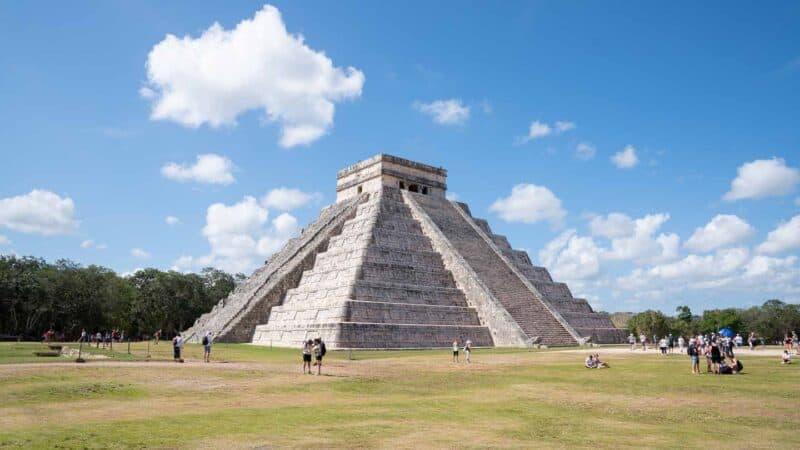
1. El Castillo – Temple of Kukulcan
El Castillo is by far one of the biggest attractions in Chichen Itza. Standing on the northern side of the city, this 100-foot-high pyramid was built for the Mayan feathered serpent deity, Kukulkan. For this reason, El Castillo is also referred to as the Temple of Kukulkan.
This nine-tiered pyramid has a series of stone serpents running down the edges. If you come during the spring or autumn equinox, you’ll see how the sun casts individual shadows that make the snakes look as if they’re moving.
2. The Great Ball Court
Another fascinating thing to see in Chichen Itza is The Great Ball Court. Despite Chichen Itza being home to 13 different courts, the Great Ball Court is the most spectacular. Measuring 551 by 230 feet, it’s the largest preserved ball court in ancient Mesoamerica.
With 26-foot-high walls, the ball court was believed to be where residents played the Mesoamerican Ballgame, which is similar to a cross between basketball and soccer. In many cases, the game was also used for sacrifice, with losers being decapitated in front of an audience – and sometimes it’s thought that human heads were used as the ball.
3. Chamber of Sacrifices
You can also visit the inside of the temple. Inside, you’ll find the “Hall of Offerings” and the “Chamber of Sacrifices.”
4. Warrior’s Temple
Besides El Castillo, Chichen Itza is also home to the Temple of the Warriors, another towering structure. The Temple of the Warriors is surrounded by over 200 round, square columns, adding to its already impressive look.
Thousands of carved warriors stand guard around the temple. At the top of the pyramid is a Chac Mool, where religious sacrifices were often made. Although you can no longer climb to the top of the stairs, you can still stand below and admire its jaw-dropping size.
5. Ossario Pyramid
Another set of pyramids is located in the Ossario Group. Like El Castillo, the Ossario pyramid comprises several step platforms. However, at the top of the pyramid is a giant hole leading to a dark cave below. During its discovery, archeologists found jade beads and skeletons within the cave.
6. Casa Colorada
Next to the Ossario Pyramid is Casa Colorada, one of the oldest buildings on the premises. Inside the Casa Colorada chambers, you can find hieroglyphics that depict the ancient rulers of Chichen Itza. These murals have been inscribed with the date 869 AD, which is the oldest date found anywhere in the ruins.
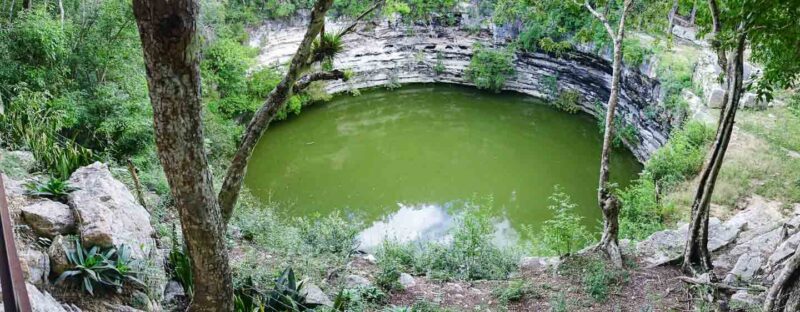
7. Cenote Chichen Itza – Sacred Cenote
Finally, you should plan on visiting the sacred cenote. Dotted throughout the Yucatan Peninsula, cenotes are deep water wells surrounded by jagged caves and cliffs. Although Chichen Itza is home to four different cenotes, the sacred cenote has the most prominent significance in Mayan culture.
During Chichen Itza’s discovery and excavation, archeologists drained the cenote to find objects, jewels, and even human remains. Due to the wounds of the remains, it’s believed that the cenote was used for human sacrifices.
Cenotes Near Chichen Itza
Don’t plan on swimming in cenote Chichen Itza. There are a ton of other Mexican cenotes nearby you can swim in. Most of the Chichen Itza tours include a stop at a cenote. For example, this tour visits Ik Kil cenote one of the most cenotes near Chichen Itza. Nearby favorites of ours are:
Tips for Visiting Chichen Itza
1. Visit Chichen Itza Independently
Although a tour guide can shed some valuable insight into the ruins, it’s much easier if you visit on your own. With a car, you can arrive and leave whenever you choose. A car also allows you to spend more time in the ruins. Most bus tours only allot two hours for exploration, which is hardly enough time to see Chichen Itza’s significant sites. Parking is only 30 pesos, which makes driving an affordable option for visiting Chichen Itza.
2. Arrive Outside Tourist Times
To avoid the crowds, we recommend visiting Chichen Itza either early in the morning or late in the afternoon. Public and tour buses arrive before lunch, making the afternoon hours the busiest time to visit. Not to mention, it’s also the hottest part of the day! This also applies to weekends and school holidays, when Chichen Itza sees an overwhelming rush of visitors and tourists.
3. Don’t Plan to Swim in the Cenotes
Unlike most Yucatan cenotes, Chichen Itza’s cenotes are off-limits. They were used for human sacrifices and burials, which means they are heavily protected and preserved. If you’re interested in swimming, you can venture to the nearby Ik Kil cenote.
4. Bring Cash
You’ll find several souvenir stalls around Chichen Itza. Many of these stalls sell handicrafts or other unique gifts to bring back home. If you plan on purchasing any items, make sure to bring cash, as most stalls are independent and do not take credit cards.
5. Hire a Local Guide
If you want to learn more about Chichen Itza’s history, you can hire a local guide to show you around the property. Several guides near the entrance will gladly explain Chichen Itza in more detail for an extra fee.
6. Dress in Layers
Comfort is critical when exploring Chichen Itza. You’ll be on your feet for most of the day, so comfortable walking shoes are recommended. It’s also a good idea to wear light, breathable layers that you can take off. It gets hot, especially during the peak of the day.
7. Bring Sun Protection
Chichen Itza isn’t protected by trees, which means shade is hard to come by. Since you’ll be out in the open sun for hours, it’s advised to bring a hat, sunglasses, and sunscreen.
8. Bring Bottled Water
You can bring small snacks and bottled water to the Chichen Itza ruins. It gets sweltering during the day, and you’ll want to stay hydrated at all times. Remember that there is little shade in Chichen Itza, which means you can quickly get dehydrated if you aren’t careful.
9. Eat in Pisté
Although it’s tempting to purchase water and snacks from the food stalls outside the entrance, you’ll be better off eating at a restaurant in Pisté. This charming village has a wide selection of places to eat and is far cheaper than the places near the ruins.
Tulum Packing List – Pack This & Not That
Final Thoughts on Visiting Chichen Itza
You can’t miss a visit to the impressive Chichen Itza ruins during your visit to the Yucatan Peninsula. Not only will you have the opportunity to explore a slice of world history, but you’ll also gain a deeper appreciation of Mayan and pre-Columbian culture.
Make sure to give yourself enough time to explore what Chichen Itza offers. Although many people visit the looming El Castillo, there’s more to Chichen Itza than this famous pyramid. By walking around and getting off the beaten path, you’re guaranteed to find something that sparks your interest!
Every year, new sites and objects in Chichen Itza are unearthed. You can return to Chichen Itza every time and find a new discovery waiting for you!

